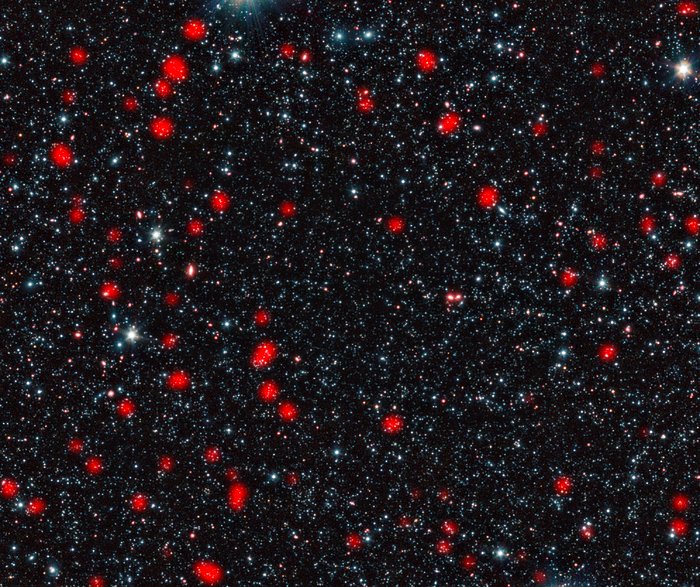Distant star-forming galaxies in the early Universe
The LABOCA camera on the ESO-operated 12-metre Atacama Pathfinder Experiment (APEX) telescope reveals distant galaxies undergoing the most intense type of star formation activity known, called a starburst. This image shows these distant galaxies, found in a region of sky known as the Extended Chandra Deep Field South, in the constellation of Fornax (The Furnace). The galaxies seen by LABOCA are shown in red, overlaid on an infrared view of the region as seen by the IRAC camera on the Spitzer Space Telescope.
By studying how some of these distant starburst galaxies are clustered together, astronomers have found that they eventually become so-called giant elliptical galaxies — the most massive galaxies in today’s Universe.
The galaxies are so distant that their light has taken around ten billion years to reach us, so we see them as they were about ten billion years ago. Because of this extreme distance, the infrared light from dust grains heated by starlight is redshifted into longer wavelengths, and the dusty galaxies are therefore best observed in submillimetre wavelengths of light. The galaxies are thus known as submillimetre galaxies.
Źródło:ESO, APEX (MPIfR/ESO/OSO), A. Weiss et al., NASA Spitzer Science Center
O zdjęciu
| Identyfikator: | eso1206a |
| Typ: | Obserwacje |
| Data publikacji: | 25 stycznia 2012 12:00 |
| Powiązane komunikaty: | eso1206 |
| Rozmiar: | 3003 x 2520 px |
O obiekcie
| Typ: | Unspecified : Galaxy : Activity : Starburst |
| Constellation: | Fornax |
| Kategoria: | Galaxies |
Współrzędne
| Pozycja (RA): | 3 32 30.50 |
| Pozycja (Dec): | -27° 48' 40.28" |
| Pole widzenia: | 30.01 x 25.19 arcminutes |
| Orientacja: | North is 90.0° prawo of vertical |
Kolory i filtry
| Pasmo | Długość fali | Teleskop |
|---|---|---|
| Podczerwony |
Spitzer Space Telescope
IRAC (Spitzer) | |
| Podczerwony |
Spitzer Space Telescope
IRAC (Spitzer) | |
| Podczerwony |
Spitzer Space Telescope
IRAC (Spitzer) | |
| Podczerwony Z | 870 nm | Atacama Pathfinder Experiment LABOCA |

